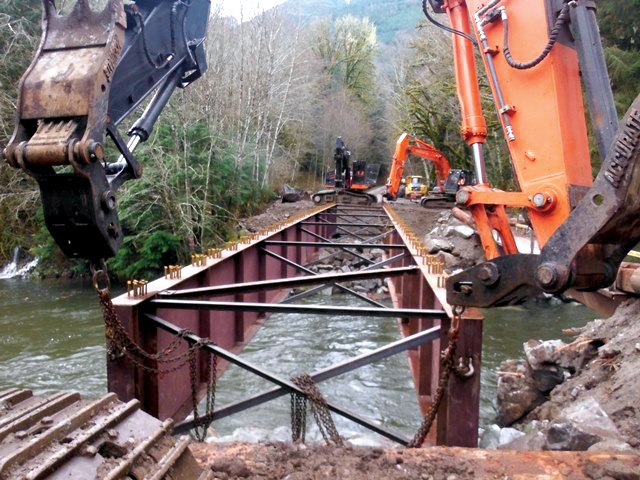Renewable energy company BluEarth says a year after acquiring a majority stake in the Narrows Inlet hydro project, road and bridge building is complete and work is getting started on the major infrastructure.
The project is a partnership between Alberta-based BluEarth and the shíshálh Nation. It got provincial and federal environmental certification in 2014, and Sunshine Coast Regional District (SCRD) zoning bylaws to allow for the powerhouses and other facilities were adopted earlier this year.
Jason Edworthy, BluEarth’s director of community and aboriginal affairs, said the first phase of the work this spring and summer will focus on the Chickwat generating station, which will be the largest of three with an output of 19 megawatts. Two smaller stations at upper and lower Ramona Creek will bring the total capacity of the project to 33 megawatts.
Edworthy also said the company has enjoyed a healthy partnership with the shíshálh Nation. They’ve already held two job fairs and there are ongoing efforts around things like training, job mentoring and opening up opportunities for companies owned by shíshálh members.
“It’s really important to us that we have this partnership. The facilities are going to be located on shíshálh territory, and in order to have success it’s great to have everybody have what we often call skin in the game,” he said. “Together both parties want to maximize the opportunities and the benefits.”
There’s also a big advantage that comes with being able to tap into the knowledge of shíshálh people on everything from navigating crew boats in the inlet to protecting the environment and archeological history of the area.
“That’s crucial,” Edworthy said. “And that’s why these partnerships make sense. When you’ve got that local knowledge, local expertise, that really helps us.”
SCRD directors were recently asked by provincial authorities to weigh in on an expansion of the project’s Crown tenure area.
They did not offer any objections, but did vote to ask the province and BluEarth to confirm that the roads will remain open to the public for recreational use.
SCRD chair Garry Nohr spoke in support of that at the May 19 planning and development committee meeting.
“The roads that were there before – especially into the new ones [facilities] they’re doing above Ramona Creek and Tyson Creek – the roads were just a disaster, and the bridges were ready to fall into the creeks,” Nohr said. “So by building new bridges and doing the roads they really enhanced it for anyone who wants to travel in the area.”
Edworthy said they expect people will continue using the area, but they’re asking for the public’s cooperation. There’s a “no wake” rule for boaters near the work camp, and they’re also being reminded to expect extra marine traffic throughout the inlet. People who want to use the roads to access the backcountry should check in with the project safety office.
Narrows Inlet is one of the last uncompleted Independent Power Projects (IPPs) in the province with a BC Hydro contract, which guarantees a market for the electricity, but Edworthy said he believes the future is bright for the renewable energy sector.
“It’s better than ever. We’ve got good technology, we’ve got good rules and regulations around it, and we’ve got lots of experience to do good jobs,” he said. “We hope that the need for clean electricity continues to grow, as well as the advantages for local economic development.”
The timeline for this project calls for the construction to wrap up and power to start flowing into the grid by late 2017.



